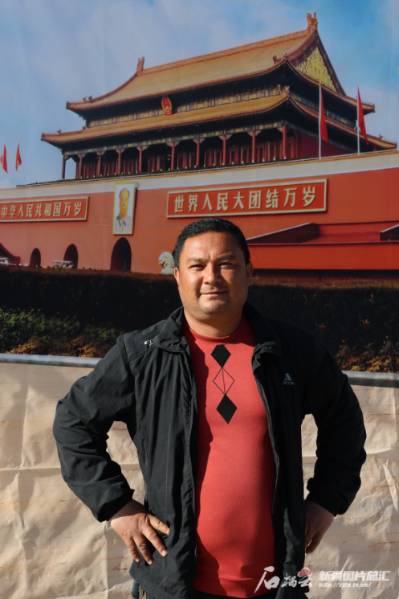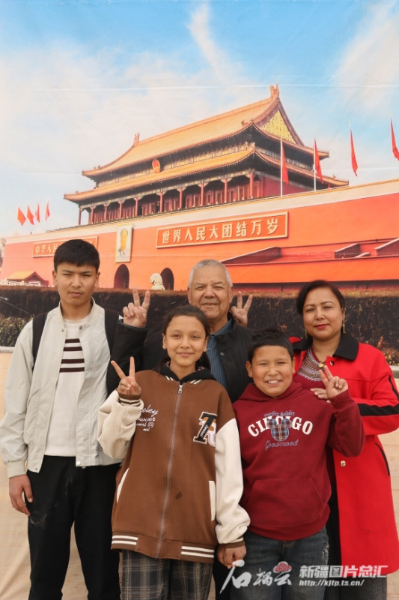| Xinjiang Today |
| Through their lens | |
|
|
 Tursun Nayip (center) strikes a pose standing in front of a Tiananmen-themed photo backdrop on March 24. (HU CHUNFANG)
In Awati Township in Hetian (Hotan) County, Hetian Prefecture, a curtain printed with the image of Tiananmen Square has become an unexpected hot photo backdrop for local residents. More than just a decorative curtain, it has witnessed unforgettable moments of locals posing before the image of the iconic landmark.
Tiananmen Square, located in the heart of Beijing, is a historic gateway originally built during the Ming Dynasty (1368-1644) and renovated in the Qing Dynasty (1644-1911). Featuring prominently on China's national emblem, it symbolizes the nation's unity and heritage.  Jilil Abula (center) poses with his eldest daughter and grandchildren in front of a Tiananmen replica backdrop in Awati Township in Hetian (Hotan) County, Hetian Prefecture (HU CHUNFANG)
A family portrait In Kumugale Village of Awati Township, nestled at the edge of the Taklimakan Desert, China's largest desert, 76-year-old Jilil Abula gathered his family for a group photo. Flanked by his eldest daughter and grandchildren, the patriarch's weathered face beamed with pride. "This isn't everyone," he told newspaper Xinjiang Daily, noting that he has four daughters, 13 grandchildren, and three great-grandchildren. Jilil, a member of the Communist Party of China for 33 years, has witnessed China's transformation firsthand, going from selling dried fruits in Fujian Province's Quanzhou City as a 25-year-old in 1979 to opening a thriving barbecue restaurant chain in Guangzhou, Guangdong Province, by the 2000s. "We lived in mud huts and survived on corn cakes as children," he reflected. Returning to Xinjiang in 2017, he entrusted his business to his daughters. Today, his homestead boasts a small farm with livestock and poultry. In the photo, three generations united before the painting of Tiananmen, their smiles a vivid testament to aspirational lives. The 'slash' life Tursun Nayip, 42, strikes a confident pose in a red sweater and black jacket, his eyes crinkling with laughter. His daily routine includes cleaning streets at 8:30 a.m., tending to cattle and managing village affairs. "I'm a part-time village leader slash crop inspector slash cattle farmer," he said. His farm yields wheat, corn, cotton and fruits. "I'm determined to help my children fulfill their dreams," he said, noting his youngest daughter's ambition to study in Beijing. In this desert frontier, Tursun and his neighbors are cultivating oases of hope—one sweatdrop at a time. She power Urnisahan Memetimin, a native of Kumugale Village, has also taken photos before the replica Tiananmen backdrop. For 30 years, Urnisahan has championed female empowerment. Her journey began in 1990, when she organized a pioneering team of women to seek employment outside Xinjiang. Kumugale Village has been plagued by frequent sandstorms, with barren land and limited arable land per capita. Villagers primarily cultivate traditional crops like wheat and corn, which yield low economic returns. From a young age, Urnisahan often heard her elders recount the stories of their business ventures in other parts of China. Even then, she sensed that the villagers were unwilling to accept their circumstances and had an adventurous spirit driving them to seek opportunities beyond their homeland. "My husband's tailoring business inspired me to seek opportunities outside Xinjiang," she said. "Our children learned about entrepreneurship from him." Today, her efforts have transformed lives: In her village, 680 villagers work outside Xinjiang, half of them women. "I encourage them to break barriers by accumulating skills and courage," she said. Framing national pride The photo initiative was proposed by Hu Chunfang, a young township government official. She came up with this idea after many villagers expressed their desire to visit Beijing, which is some 4,000 km away, Hu said. She purchased the curtain backdrop and coordinated equipment, as well as visited households to snap pictures for them. Villagers responded enthusiastically, some changing into post-harvest festive attire, just for a photo. Each photo is stamped with a QR code for easy sharing. In an era of smartphone selfies, Awati's villagers still choose to don their finest and stand before a printed Tiananmen Square. Their choice reflects a truth: Though distant, Tiananmen stands as a symbol of unity and pride, right in their hometown. Comments to taozihui@cicgamericas.com |
|
||||||||||||||||||||||||||||
|